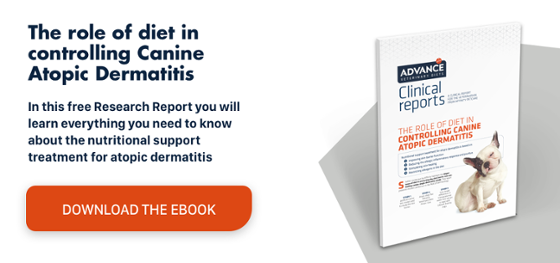Skin infections in dogs with atopic dermatitis
Skin infections are one of the most common complications of canine atopic dermatitis, a disease that affects approximately 10% of dogs according to D. N Carlott1. The problem stems from the fact that atopic dermatitis weakens the skin barrier, a vulnerability that microorganisms, such as bacteria and yeasts, use to colonise and reproduce in the skin.
In fact, it is estimated that approximately 66% of dogs with atopic dermatitis suffer from secondary bacterial infections or pyoderma and 33% have Malassezia dermatitis, according to a study by Favrot C2.
What causes skin infections in dogs with atopic dermatitis?
Most skin infections in dogs with atopic dermatitis are caused by the bacterium Staphylococcus intermedius, althoughStaphylococcus schleiferi and, to a lesser extent, S. pseudintermedius can also affect dogs. Colonies of Gram-negative bacteria, such as Proteus, Pseudomonas and coliform bacteria, may be found in some cases. Infection with Malassezia, a type of fungus, is also common.
Although these pathogens can affect any animal, there are certain risk factors that increase the chances of developing an infection. Dogs suffering from pruritus, either due to a self-inflicted injury, the use of corticosteroids or immunological abnormalities caused by atopic dermatitis, have an increased risk of developing a skin infection, according to research carried out by Hensel et al.3.
Dogs with seborrhoeic processes that course with inflammation, follicular obstruction and/or degeneration, and those with endocrine disorders, such as hypothyroidism or diabetes, are also more vulnerable to developing a skin infection.
How can we control skin infections in dogs with atopic dermatitis?
The treatment of choice for skin infections in dogs with atopic dermatitis is antibiotic therapy. Azithromycin at a dose of 12 mg/kg is recommended every 12 hours to combat Gram-negative infections and lincomycin at 22 mg/kg every 12 hours for Staphylococcus infections.
In animals with a mild or moderate infection, erythromycin is recommended at a dose of 10–15 mg/kg every 8 hours. In more complex cases, amoxicillin can be given at a dose of 25 mg/kg every 12 hours and oxacillin at 22 mg/kg every 8 hours to treat the infection and attenuate symptoms.
Topical therapy is also useful for controlling skin infections in dogs with atopic dermatitis. In these cases, the use of 2% mupirocin usually presents good results, especially if it is combined with baths in shampoos that have a restructuring, anti-irritant and calming effect, such as the Advance Veterinary Diets Atopic shampoo; a formula based on aloe vera, collagen and olive leaf extract created especially for dogs with dermatitis that helps maintain an intact skin barrier, reduces inflammation and provides antimicrobial activity.
Nutrition is also useful for controlling skin infections in dogs with atopic dermatitis. A correctly formulated diet can mitigate many of the characteristic clinical signs of the disease, reinforce the epidermal barrier and regulate certain indicators, such as water loss and skin pH which are particularly affected in some breeds of dogs with atopic dermatitis, as explained in the studies in our Clinical Report on Canine Atopic Dermatitis4.
A diet based on Atopic Rabbit and Peas, a dietary food created to relieve the clinical signs associated with atopic skin disorders, will help keep skin hydrated, reduce inflammation, decrease the risk of developing adverse food reactions and control excessive hair loss.
This effect can be enhanced with Dermaforte, a dietary supplement based on essential fatty acids that strengthens the epidermal barrier, reduces inflammation and skin lesions, while improving the coat’s appearance. We also recommend restricting the consumption of allergen-containing foods, such as gluten or wheat, and increasing the intake of foods rich in omega fatty acids and vitamin E.


